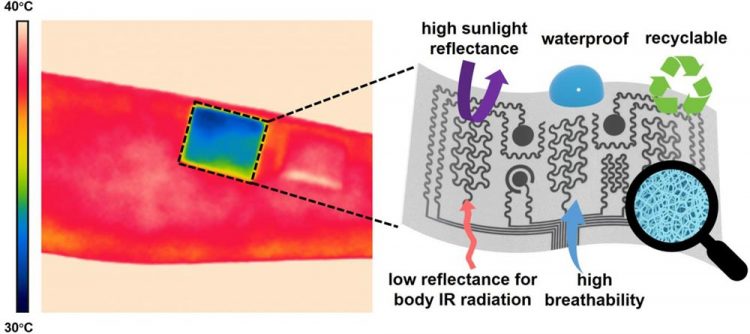Wearable AC

An on-skin device designed by engineers at the University of Missouri can achieve around 11 degrees Fahrenheit of cooling to the human body. The device also includes numerous human health care applications such as the ability to monitor blood pressure, electrical activity of the heart and the level of skin hydration. Credit: University of Missouri
One day, soldiers could cool down on the military battlefield — preventing heat stroke or exhaustion — by using “wearable air conditioning,” an on-skin device designed by engineers at the University of Missouri.
The device includes numerous human health care applications such as the ability to monitor blood pressure, electrical activity of the heart and the level of skin hydration.
The findings are detailed in the journal Proceedings of the National Academy of Sciences.
Unlike similar products in use today or other related concepts, this breathable and waterproof device can deliver personal air conditioning to a human body through a process called passive cooling. Passive cooling does not utilize electricity, such as a fan or pump, which researchers believe allows for minimal discomfort to the user.
“Our device can reflect sunlight away from the human body to minimize heat absorption, while simultaneously allowing the body to dissipate body heat, thereby allowing us to achieve around 11 degrees Fahrenheit of cooling to the human body during the daytime hours,” said corresponding author Zheng Yan, an assistant professor in the College of Engineering. “We believe this is one of the first demonstrations of this capability in the emerging field of on-skin electronics.”
Currently, the device is a small wired patch, and researchers say it will take one to two years to design a wireless version. They also hope to one day take their technology and apply it to 'smart' clothing.
“Eventually, we would like to take this technology and apply it to the development of smart textiles,” Yan said. “That would allow for the device's cooling capabilities to be delivered across the whole body. Right now, the cooling is only concentrated in a specific area where the patch is located. We believe this could potentially help reduce electricity usage and also help with global warming.”
###
The study, “Multiscale porous elastomer substrates for multifunctional on-skin electronics with passive-cooling capabilities,” was published in Proceedings of the National Academy of Sciences. Other authors include Yadong Xu, Bohan Sun, Yun Ling, Qihui Fei, Zanyu Chen, Xiaopeng Li, Shivam Goswami Yixuan Liao, Shinghua Ding, Qingsong Yu, Jian Lin and Guoliang Huang at MU; Peijun Guo and Nari Jeon at Argonne National Laboratory in Lemont, Illinois.
Funding was provided by the University of Missouri start-up fund and a grant from the Air Force Office of Scientific Research. The content is solely the responsibility of the authors and does not necessarily represent the official views of the funding agencies.
Media Contact
All latest news from the category: Health and Medicine
This subject area encompasses research and studies in the field of human medicine.
Among the wide-ranging list of topics covered here are anesthesiology, anatomy, surgery, human genetics, hygiene and environmental medicine, internal medicine, neurology, pharmacology, physiology, urology and dental medicine.
Newest articles

Going Steady—Study Reveals North Atlantic’s Gulf Stream Remains Robust
A study by the University of Bern and the Woods Hole Oceanographic Institution in the USA concludes that the ocean circulation in the North Atlantic, which includes the Gulf Stream,…

Single-Celled Heroes: Foraminifera’s Power to Combat Ocean Phosphate Pollution
So-called foraminifera are found in all the world’s oceans. Now an international study led by the University of Hamburg has shown that the microorganisms, most of which bear shells, absorb…

Humans vs Machines—Who’s Better at Recognizing Speech?
Are humans or machines better at recognizing speech? A new study shows that in noisy conditions, current automatic speech recognition (ASR) systems achieve remarkable accuracy and sometimes even surpass human…



